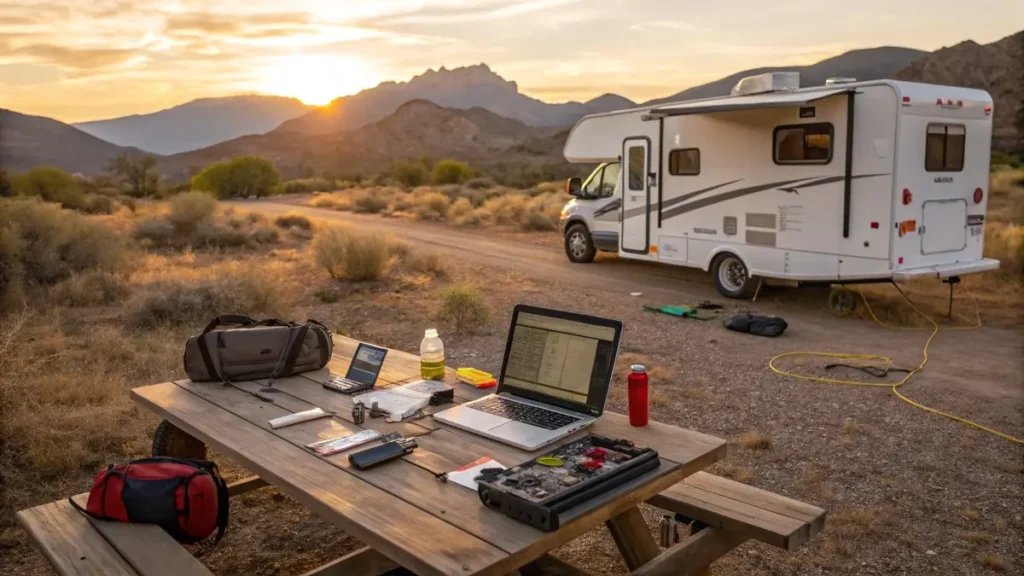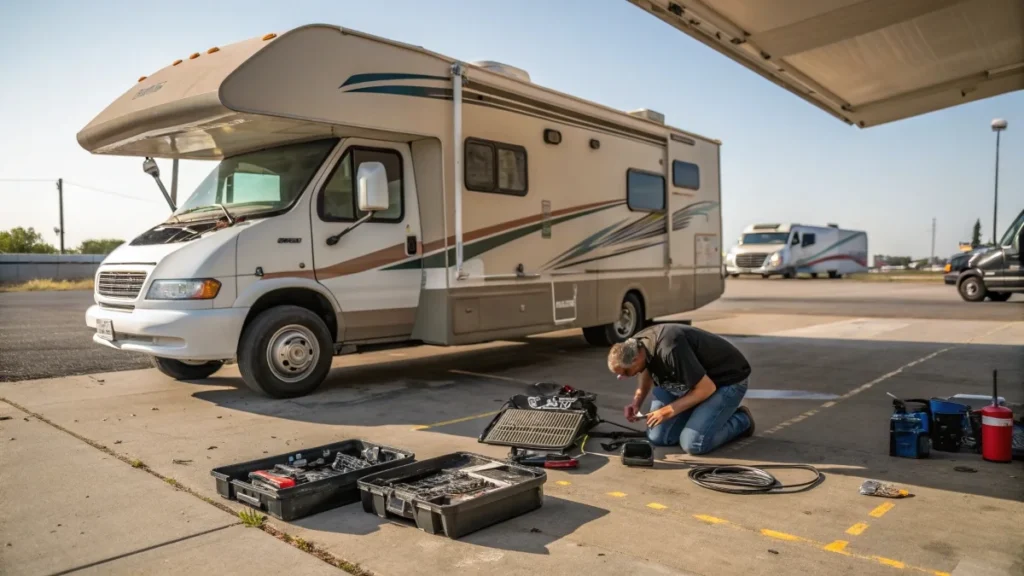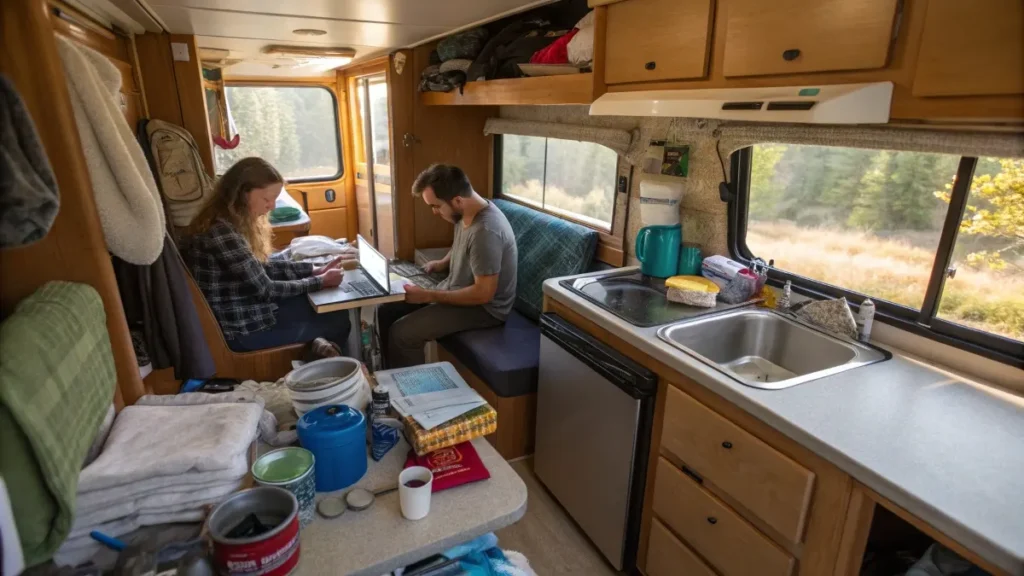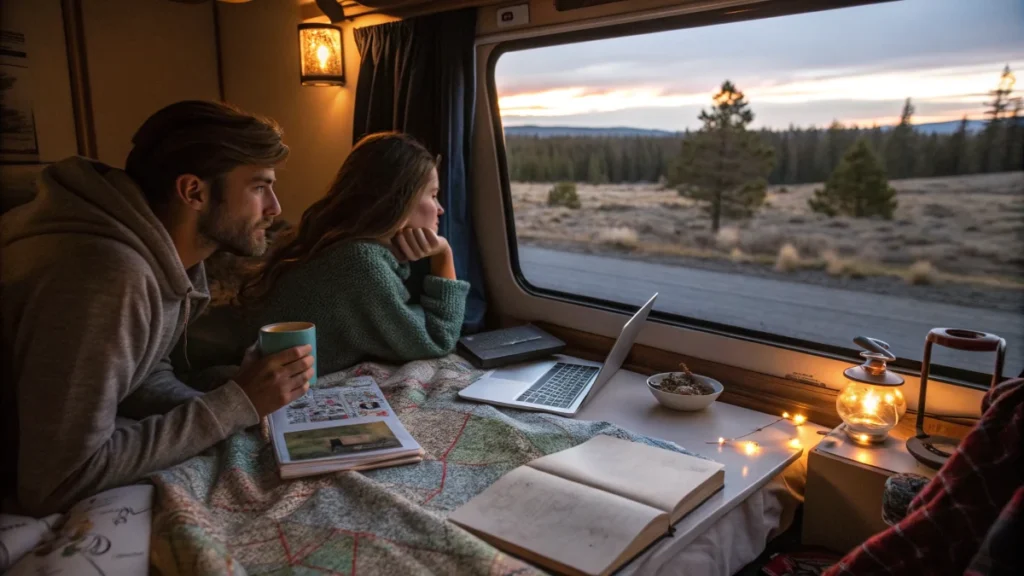Selling everything you own to live in a 300-square-foot box on wheels is the ultimate adventure but the reality behind the Instagram posts is often more about spreadsheets and sewer hoses than sunsets.
If you’re reading this, you’ve probably seen the gorgeous photos of RVs parked by serene lakes and felt the pull of the open road. But you also have that nagging feeling in the back of your mind: What are we not seeing? What are the hard parts nobody talks about?
You need a reality check to make sure your dream doesn’t become a costly, stressful nightmare. This guide is here to give you that. We’re sharing 14 critical, real-world lessons we wish we knew before starting RV life full-time.
This is the practical advice that will help any full-time RV living for beginners avoid the biggest headaches. We’ll cover everything from the real cost of living on the road to the surprising mental shifts you’ll face.
The True Cost of Full-Time RVing: Budgeting Surprises

Our first month on the road cost nearly double our projection. Here’s why your budget is just the beginning.
1. Your Initial Budget is a Guideline, Not Gospel
You’ve probably made a detailed budget. That’s a great start. But the first three months on the road will test it in ways you can’t predict. One trip through the mountains can blow your fuel budget completely. A popular campground might charge resort fees you didn’t expect. These small things add up fast. Think of your initial budget as a rough draft. Track every dollar for the first 90 days, and then create your real budget based on that data.
2. The “RV Emergency Fund” is Non-Negotiable
You have a personal emergency fund for medical bills or job loss. Good. Now you need a separate one just for the rig. This isn’t for you; it’s for your house on wheels. When a slide motor dies, a tire blows on the highway, or your water heater quits in the middle of a cold night, you can’t wait. These are often immediate, expensive fixes. A good rule of thumb is to have at least $3,000-$5,000 in a dedicated RV repair fund at all times.
3. Hidden Costs Are Everywhere
The big expenses like fuel and campsites are obvious. The small, recurring costs are what sneak up on you.
- Insurance: RV insurance is more complex than car insurance. Your rate will depend on where you claim residency and the type of coverage you get.
- Mail Forwarding: Services like Escapees RV Club or Traveling Mailbox cost $20-$30 a month.
- Propane: If you’re camping in the cold, you might go through a 30 lb tank every week.
- Vehicle Registrations: You still have to register your truck and trailer, which can be expensive depending on your home state.
Beyond the Build: Ongoing Van Life Costs
Insurance
More complex than car insurance; rates depend on residency and coverage type (e.g., RV vs. standard).
Mail Forwarding
Essential services like Escapees or Traveling Mailbox typically cost $20-$30 per month.
Propane
Heating in cold weather can consume a 30 lb tank weekly, a significant recurring expense.
Vehicle Registrations
Annual registration fees for your truck and trailer vary significantly by your chosen home state.
Your RV Will Break: A Guide to Maintenance & Repairs

Think of your RV not as a vehicle, but as a house experiencing a constant earthquake. Things are going to break.
4. You Are Now a Part-Time Mechanic (and Plumber)
Things break on an RV constantly. A water fitting will leak. A fuse will blow. A cabinet latch will snap. You can’t call a repair person for every little thing. You must have a basic toolkit and be willing to learn. YouTube is your best friend. Learning to fix small problems yourself will save you thousands of dollars and countless hours of frustration. This is a critical skill for full-time RV living for beginners.
5. Finding a Reputable RV Tech is Harder Than You Think
For the big problems you can’t fix, you’ll need a professional. But RV dealership service centers often have wait times of weeks, or even months. Your best option is often a mobile RV technician who comes to you. But not all are created equal. Look for certified technicians through directories like the National RV Technicians Association (NRVTAA) to find someone reliable.
6. Gross Vehicle Weight Rating (GVWR) Isn’t a Suggestion
Every RV has a maximum weight it can safely carry, called the GVWR. It’s printed on a sticker inside your rig. Overloading your RV is one of the most dangerous RV life mistakes you can make. It puts immense stress on your tires, axles, and brakes, leading to blowouts and accidents. Pack light, and then get rid of more stuff. Take your fully loaded rig to a CAT Scale at a truck stop to get it weighed. It costs about $15 and gives you the peace of mind that you’re traveling safely.
Learning to reseal our roof a year in saved us an estimated $1,500 and prevented catastrophic water damage. If you’re not sure where to start with electrical issues, find a good YouTube video showing how to perform a simple RV electrical diagnosis with a multimeter.
The Nitty-Gritty of Daily Life on the Road

The “freedom” of the open road is built on a surprising amount of daily and weekly planning. Let’s break down the big challenges: Internet, travel, parking, mail, and groceries.
7. Internet is a Constant Battle
If you work from the road, reliable internet is not guaranteed. In 2025, there are two main choices: Starlink or cellular plans (like Verizon, T-Mobile, or AT&T) with a signal booster. Neither is perfect. Starlink needs a clear view of the sky, which is a problem in forested areas. Cellular plans depend on tower location, and some beautiful, remote spots have zero service. Most full-timers use a combination of both to stay connected.
8. Planning Your Route is a Part-Time Job
You can’t just type a destination into Google Maps and go. RV apps like RV LIFE Trip Wizard are essential because they account for road restrictions. Is there a low-clearance bridge on that route? Is that mountain pass too steep for your rig? You also have to plan for fuel stops, overnight parking, and booking popular campsites 6-12 months in advance.
9. “Finding a Spot” Isn’t Always Easy
There are three main ways to camp:
- Private Campgrounds: Offer full hookups (water, power, sewer) but can be expensive and tightly packed.
- State/National Parks: Often more scenic and spacious, but may lack hookups and get booked up far in advance.
- Boondocking: Free camping on public lands, but you need to be self-sufficient with water, power (solar/generator), and waste tanks.
Where Will You Sleep Tonight?
Private Campgrounds
Full hookups, but can be expensive and often tightly packed. Book in advance!
State/National Parks
Scenic and spacious, but limited hookups and often require early booking.
Boondocking
Free camping on public land; requires self-sufficiency for all utilities.
10. Getting Mail and Packages is a Puzzle
How do you get mail when you don’t have a permanent address? You use a mail forwarding service. They give you a physical address, scan your mail so you can read it online, and forward important packages to you wherever you are. For online orders, Amazon Lockers or sending packages via General Delivery to a local post office are great options.
11. Grocery Shopping Requires Strategy
Your RV has a tiny refrigerator and pantry. This means you can’t do a big weekly shopping trip anymore. You’ll be at the grocery store every few days. This can be a challenge in rural areas where the closest store is 45 minutes away or doesn’t carry the specific items you like.
We learned this the hard way when we tried to visit Zion National Park in October without reservations. The closest available campground was over an hour away. This is a classic RV life mistake. Using apps like Campendium and The Dyrt for reviews and planning is essential before starting RV life full-time.
The Mental Game: Relationship & Lifestyle Adjustments

You’ve planned the budget and learned the systems, but the biggest challenge for many is the mental adjustment.
12. You Have Too Much Stuff, I Promise
You will spend months downsizing, selling, and donating your belongings. You’ll feel proud of how minimalist you’ve become. Then, three months into your travels, you’ll realize you still have too much stuff. The second (and third) purge is a rite of passage for every full-timer. Be ruthless. If you haven’t used it in a month, you probably don’t need it.
13. The Pace is Slower, And That Can Be Uncomfortable
Moving from a structured 9-to-5 life to a fluid, weather-dependent one is a huge shift. At first, the freedom is amazing. But then, the “analysis paralysis” can set in. With endless options of where to go next, it can be hard to make a decision. You have to learn to slow down, be present, and accept that you can’t see everything.
14. Loneliness is Real, But So is Community
Leaving your friends and family behind is hard. There will be times when you feel lonely and isolated. The good news is that the RV community is incredibly welcoming. You can find your people through RV clubs like Full-Time Families, campground social events, or online groups. You have to put yourself out there, but you’ll build friendships with people who truly get your lifestyle.
After starting RV life full-time, we realized our biggest arguments were about navigating in tight spaces or setting up camp when tired. We had to create a system and communicate better. It’s a common story in full-time RV living; the small space magnifies every issue.
Navigating Life on the Road
From Lonely to Connected
Leaving friends and family is tough, but the RV community is incredibly welcoming. You can find your people through RV clubs, campground events, and online groups. You have to put yourself out there, but you’ll build friendships with people who get your lifestyle.
From Strain to System
Arguments over navigating or setting up camp are common—the small space magnifies every issue. We realized we had to create a system and communicate better. It’s a crucial step to harmony in full-time RV living.

